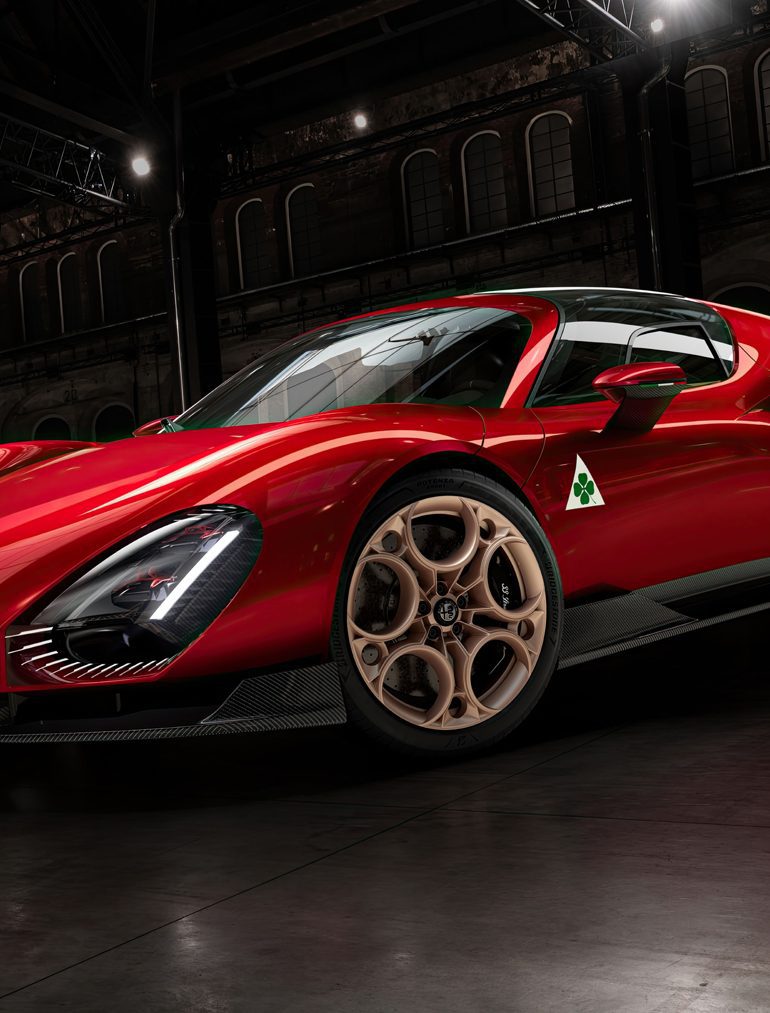Alfa Romeo is delighted to announce the rebirth of the “fuoriserie” (custom-built) 33 Stradale, a genuine manifesto of the Italian brand’s current and future capabilities in terms of style and driving experience. With only 33 exclusive copies of the 33 Stradale to be built, aligned with a unique artisan process, the new two-seater coupé combines Alfa Romeo’s heritage and future as a symbol of noble Italian sportsmanship.
The new 33 provides an exciting driving experience and the immortal charm of an icon to a very small circle of enthusiasts who have been involved from the beginning. The new 33 Stradale was developed at the recently created Alfa Romeo “Bottega,” where the brand’s designers, engineers and historians initially met with potential buyers to create each car, as in Renaissance artisan boutiques and workshops of renowned Italian coachbuilders.
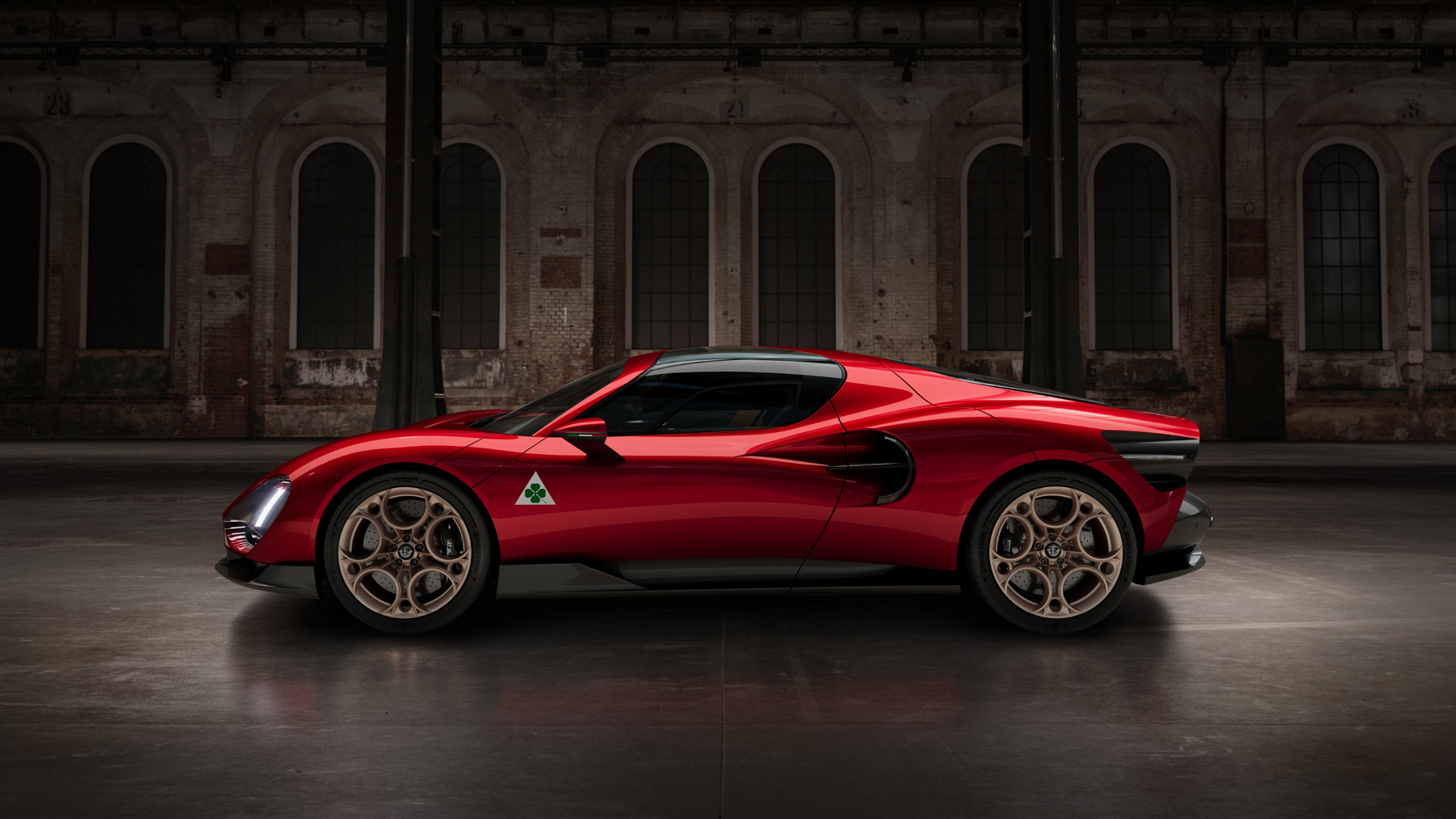
Necessary beauty
Produced by the Alfa Romeo Centro Stile, the new 33 Stradale is inspired by the historic 1967 model, with enrichments to the sculptural beauty and design elements from Alfa Romeo’s new style language. The exterior perfectly balances proportions, volumes and surface properties to achieve the epitome of Alfa Romeo’s necessary beauty. The forward design has a powerful and muscular stance. Standout features include the iconic shield and complex elliptical-base lighting.
The profile is dynamic and slender, with butterfly doors that feature two large air inlets. The body is projected forward, with surfaces modeled according to Alfa Romeo’s formal expression. Corner openings of the doors and the large wraparound sunroof give the driver a unique, aircraft cockpit view. Opening the bonnet and doors enhances the car’s theatrical design. The beautiful design also slips through the air with aerodynamic efficiency. A Cx of 0.375 at zero Cz is achieved without the aid of active systems.
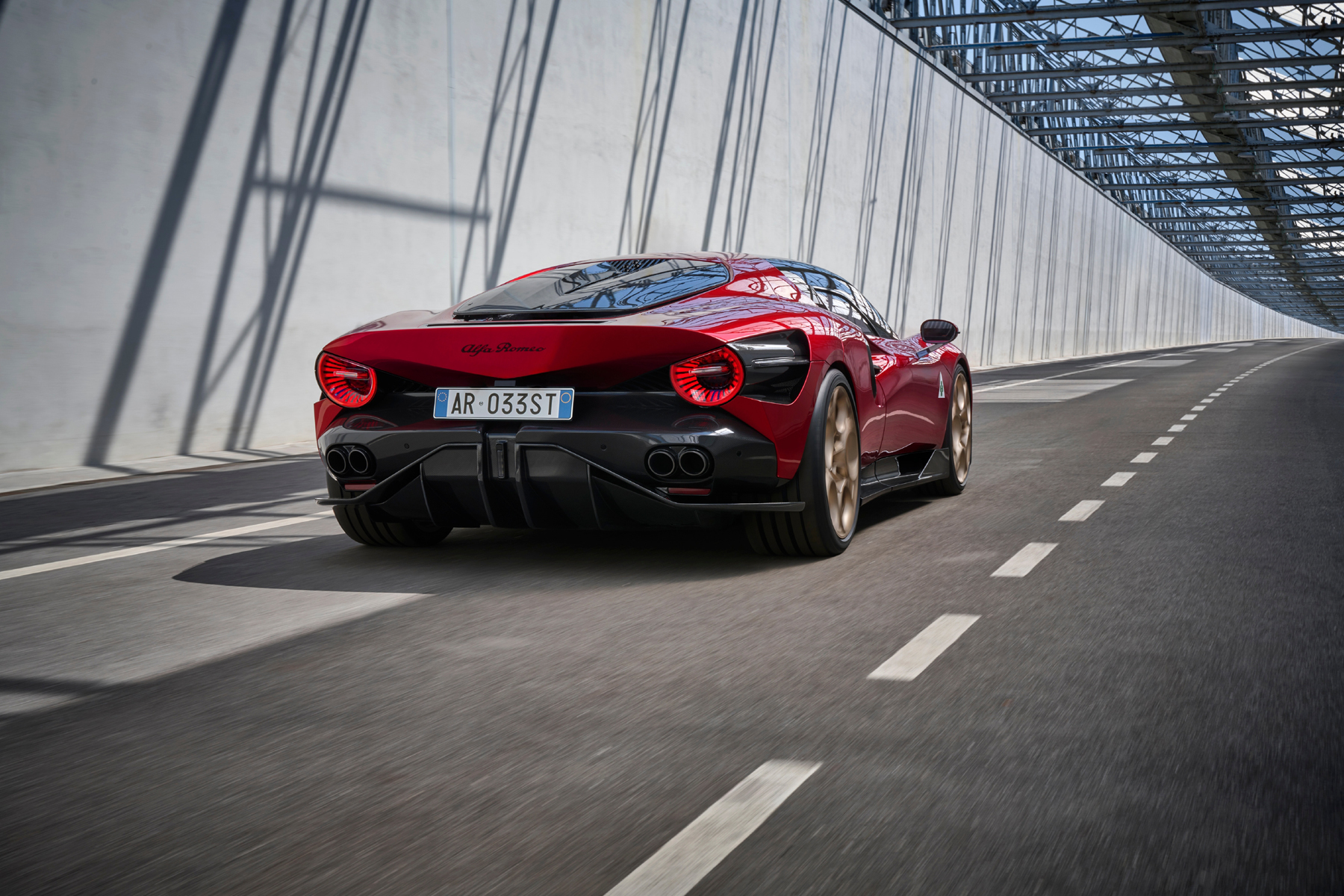
Interior
Two trim levels are available: Tributo and Alfa Corse. The interior is an example of minimalistic design aimed at the greatest possible driving engagement without distracting the driver. The limited number of controls for common systems can be found on the center console. Directly ahead of the driver is the 3D telescope display, which engages the driver in a first-of-its-kind interaction.
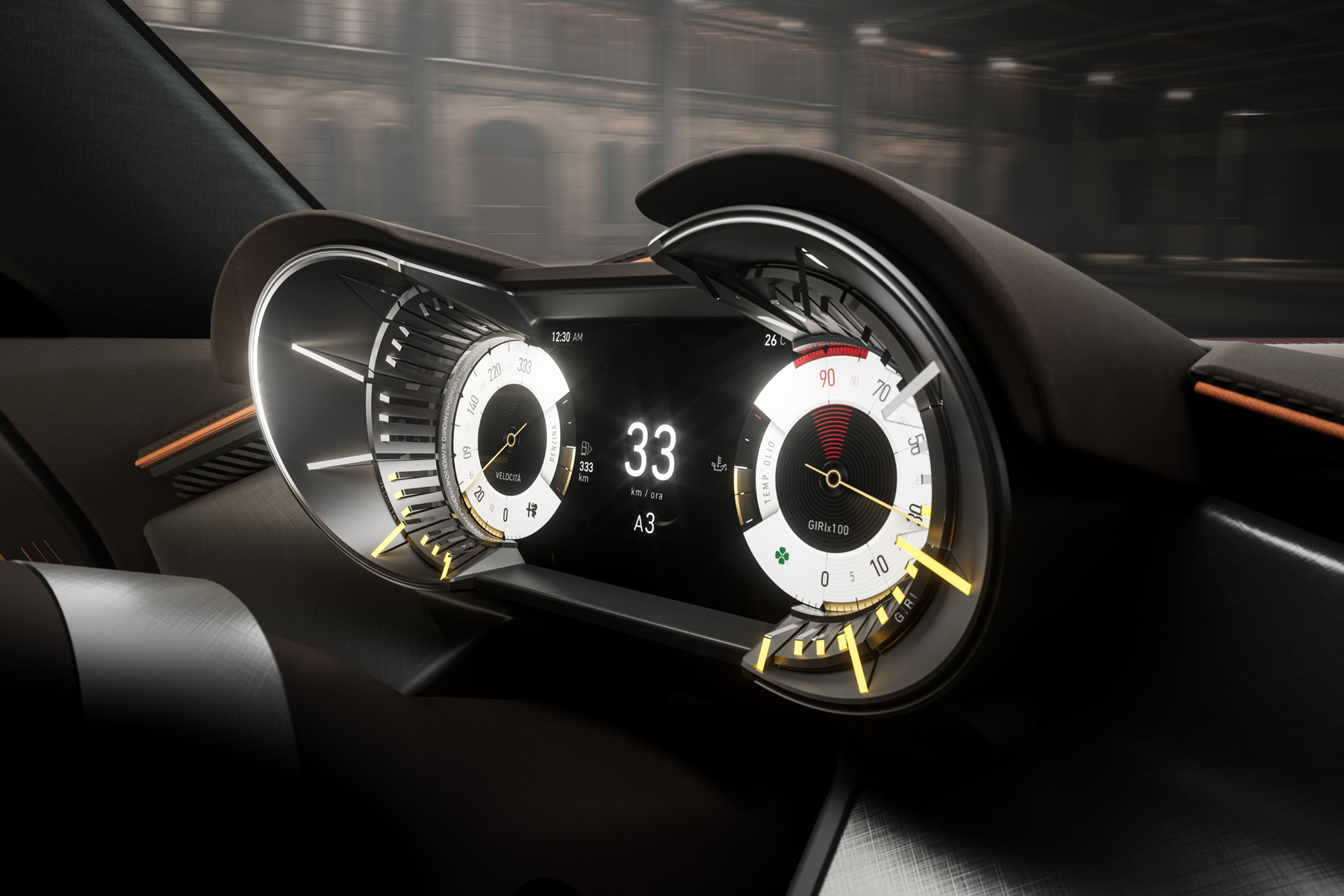
The steering wheel, devoid of all its usual buttons, offers an experience of pure driving pleasure. The cockpit-style instrument panel features controls located at different levels, including overhead, in the lining of the roof. The aviation-inspired dashboard and central tunnel employ aluminum, carbon fiber, leather and Alcantara materials. Wraparound seats reinterpret those of its forerunner, ensuring comfort and ergonomics. Every detail is designed to create an exclusive and engaging environment, maintaining the aesthetic and technical heritage of the 1967 33 Stradale.
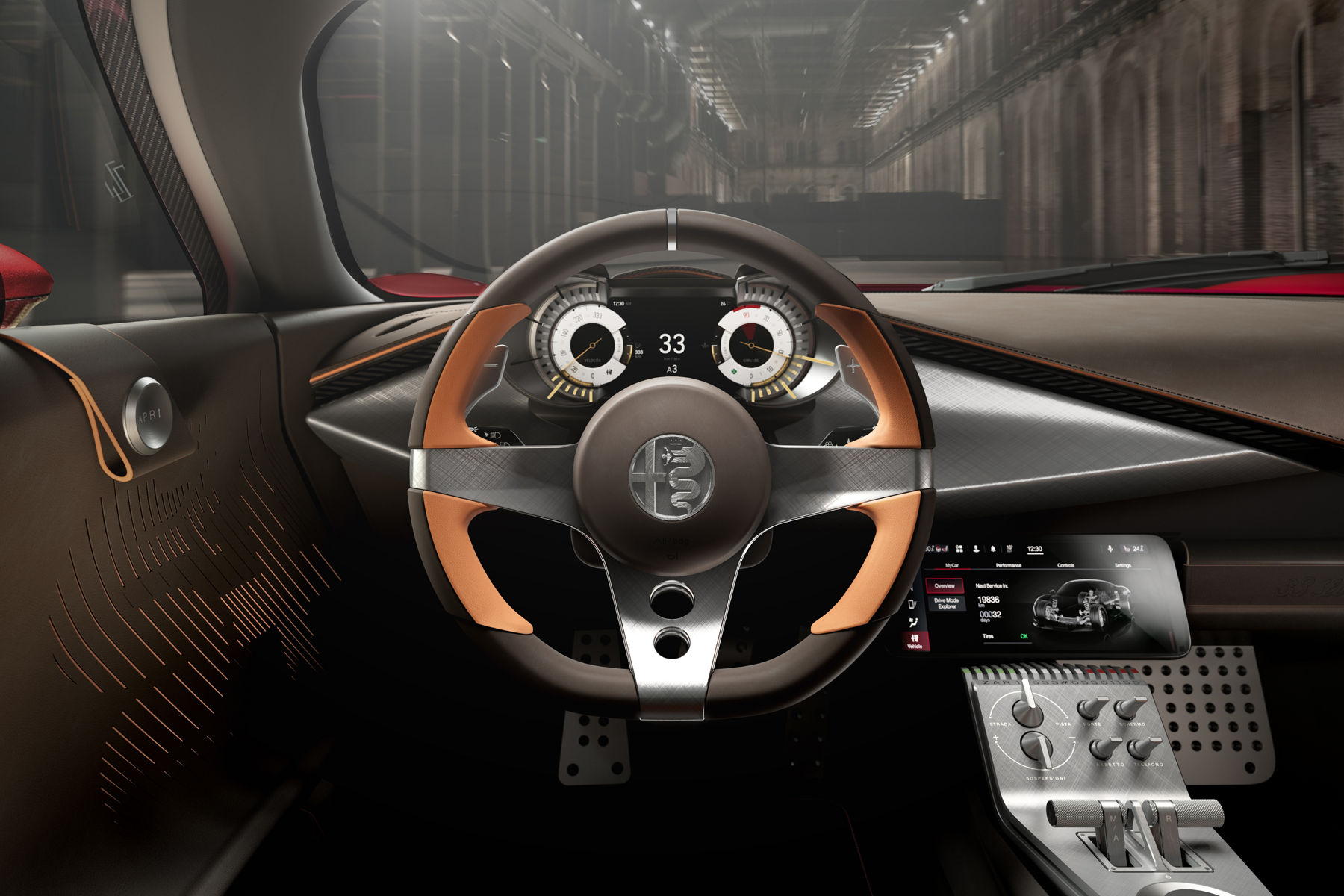
A unique driving experience
The Alfa Romeo team has set the ambitious goal of offering a driving experience as a track car, yet in a model suitable for everyday use on the road, without compromising comfort and safety. Working with F1 driver Valtteri Bottas, the Finnish champion will support the car’s tuning at the Balocco Proving Ground in Vercelli province of Italy, thus bringing F1 experience into everyday driving and ensuring Alfa Romeo’s unmistakable handling.
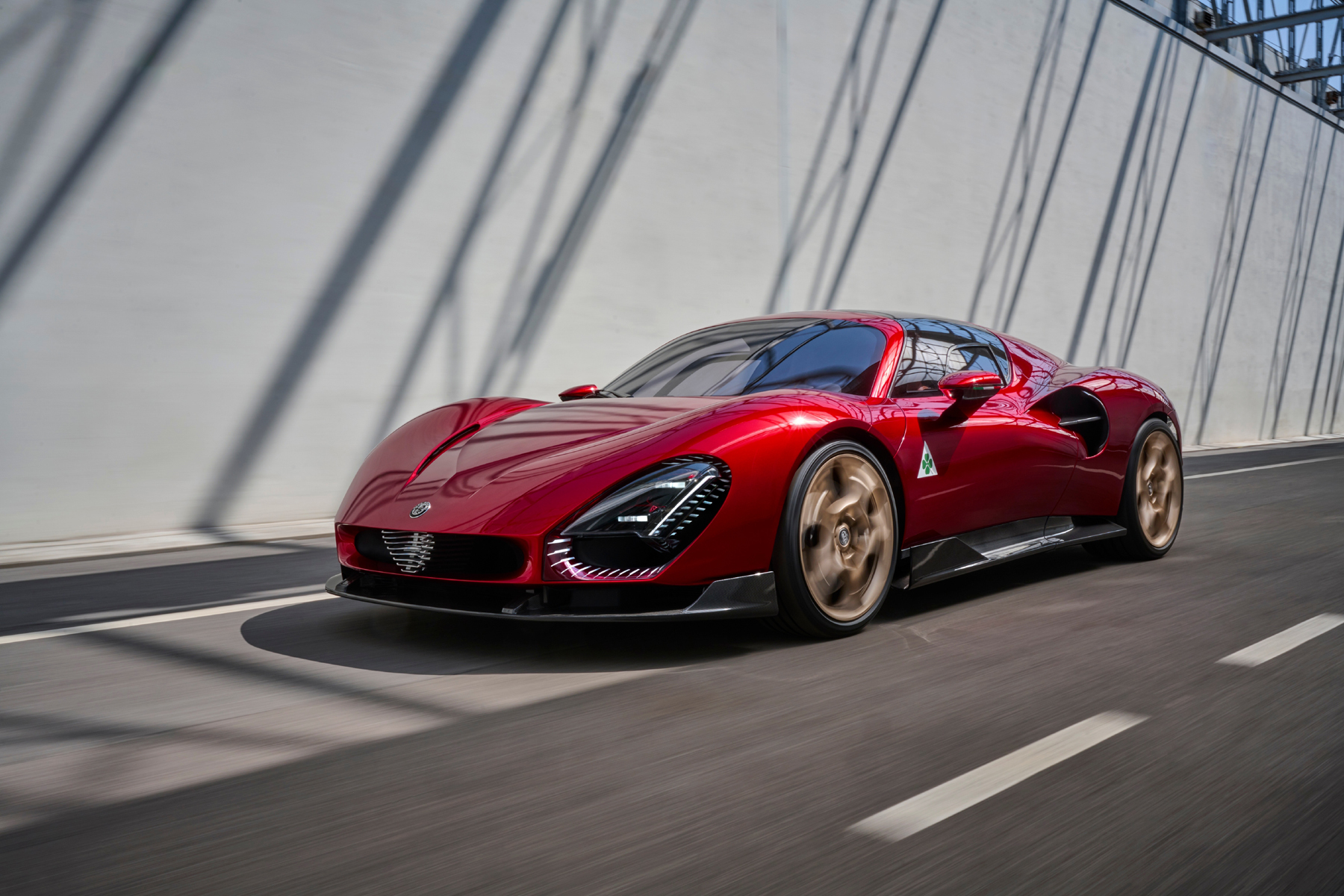
Power options
The new Alfa Romeo can be fitted with a V-6 twin-turbo engine, delivering more than 620 horsepower. Routed through an eight-speed DCT gearbox to the rear wheels, an electronic limited-slip differential assists in putting force to ground. The optional BEV configuration delivers more than 750 horsepower with a WLTP range of 450 km. Performance is outstanding in both versions. The top speed is 206 mph/333 km/h with a 0 to 100 km/h time of less than three seconds.
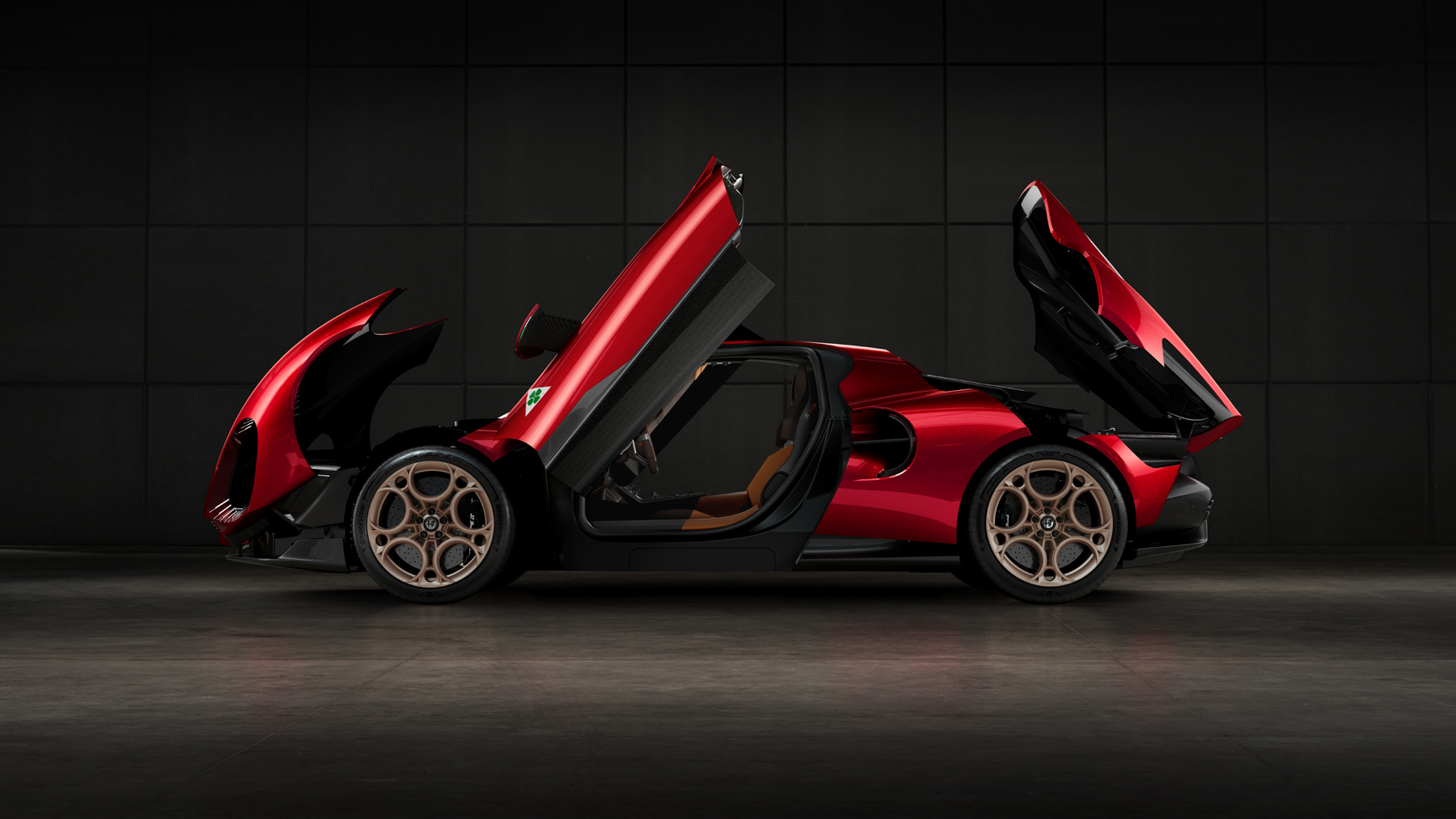
Chassis
The new 33 Stradale boasts the best of Alfa Romeo engineering, with double-arm, active suspension. A front axle lift system enables lifting the front when passing obstacles, such as bumps, rails or when entering parking lots or garages to avoid damage to the bodywork. The driver can activate this function via the “Assetto” (setup) control on the center console when driving under 40 km/h. The hydraulic system raises the front axle by nearly 50mm to overcome the obstacle. The system returns to the standard height by manually deactivating the system or when exceeding the set speed limit.
The aluminum H-frame and carbon-fiber monocoque promise rigidity and lightness. To ensure high-quality of rigidity and safety, a roof structure has been engineered in carbon fiber and aluminum, which supports the hinged butterfly doors. The window frames also are made of carbon fiber. Continuing with the lightweight theme, the rear window is made from polycarbonate.
A drive mode selector on the central tunnel has two modes of operation. Strada (road) mode is engaged when the car is started, which ensures comfort and driving pleasure with smooth power delivery, mild pedal sensitivity, compliant suspension and active exhaust valves that will not open below 5,000 rpm. In Pista (track) mode, the customer chooses an adrenaline-fueled, open exhaust valve option with peak power, increased pedal sensitivity and firm suspension for greater handling. Fast Start (launch control) is available via the Quadrifoglio button on the center tunnel. The system works the gearbox, traction control and power delivery to maximize acceleration by avoiding wheel slippage. In Pista mode, the driver can also choose to deactivate the traction control systems.
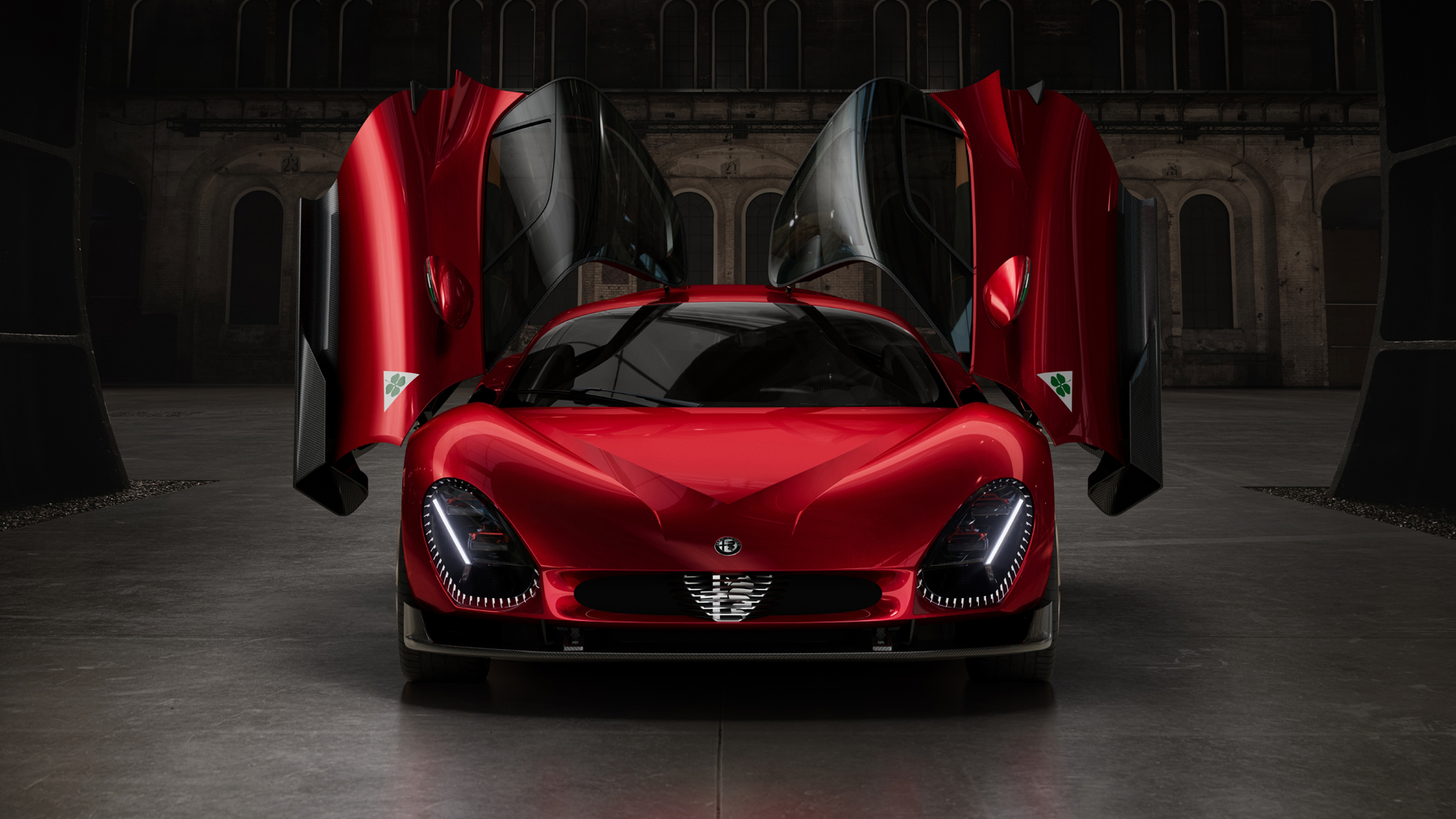
Braking
The Alfa Romeo brake-by-wire system and Brembo carbon-ceramic brakes offer a high-level performance stopping power — from 100 km/h to 0 in under 33 m. Control of braking pressure and stability depends on which drive mode is selected. Produced by Brembo for Alfa Romeo, carbon-ceramic brakes guarantee high performance and ensure reactive braking with a reduced fading effect at high temperatures. In the front and rear, the discs are ventilated and perforated with a six-piston monobloc caliper in aluminum in the front and a four-piston system in the rear.
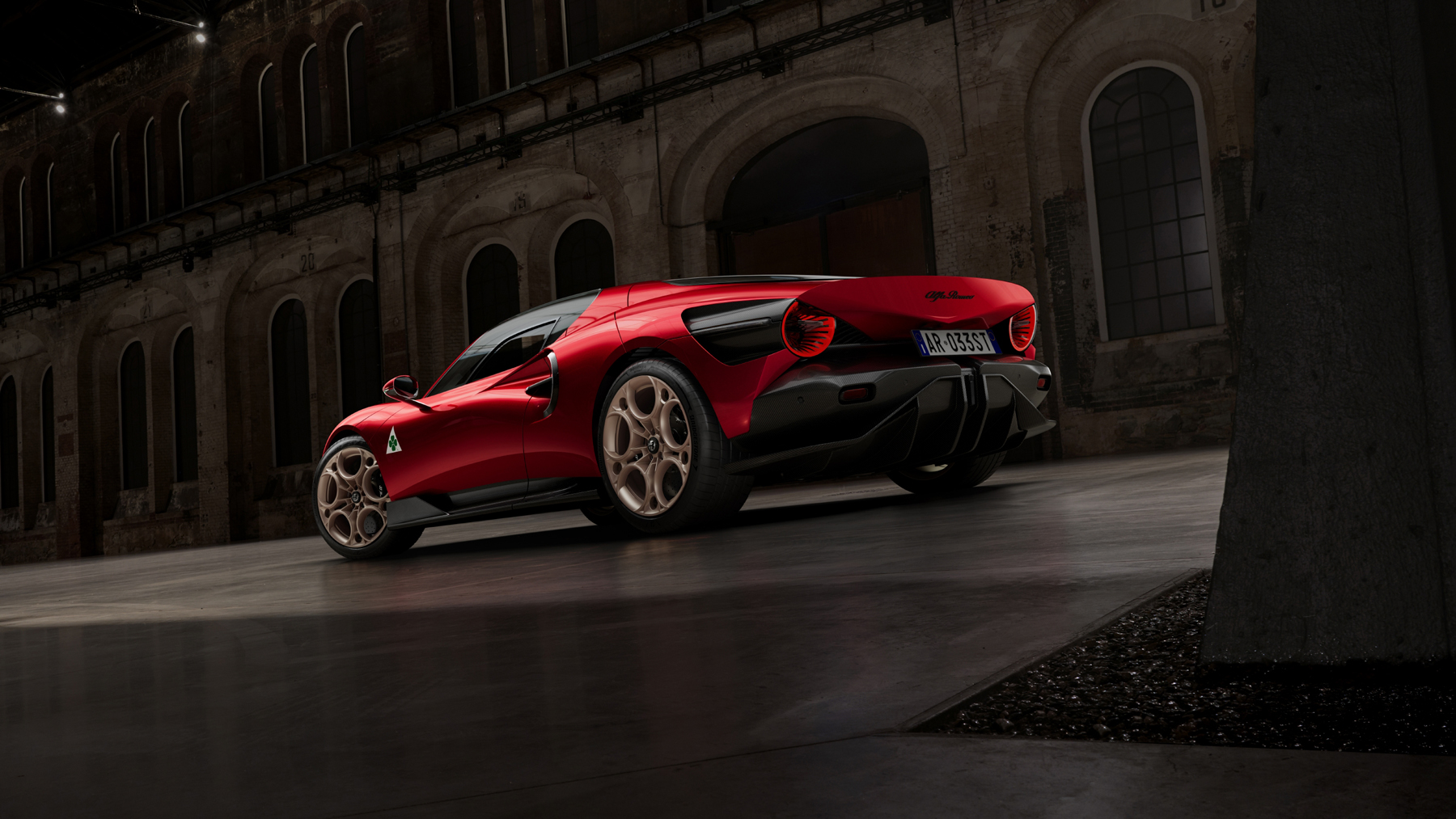
The Bottega
The 33 project created a need for the Alfa Romeo Bottega, a team of professionals who have worked closely with customers to design 33 unique and exclusive vehicles. The Bottega is inspired by Renaissance workshops and 1960s coachbuilders, who created works of pure beauty, according to their clients’ requirements. Likewise, customers were involved in the creative process from the beginning of the 33 project. The first meetings with some customers occurred at the 2022 Monza Grand Prix, where the opportunity to express desires began. Within a few weeks, all 33 units were sold. The Bottega is headquartered in the Sala del Consiglio of the museum in Arese, where the design of the 1967 33 Stradale was approved. To ensure the history and iconic character are respected, final approval of each car was completed by the 33 Committee. Chaired by the CEO of Alfa Romeo, the group includes brand leadership in various departments.
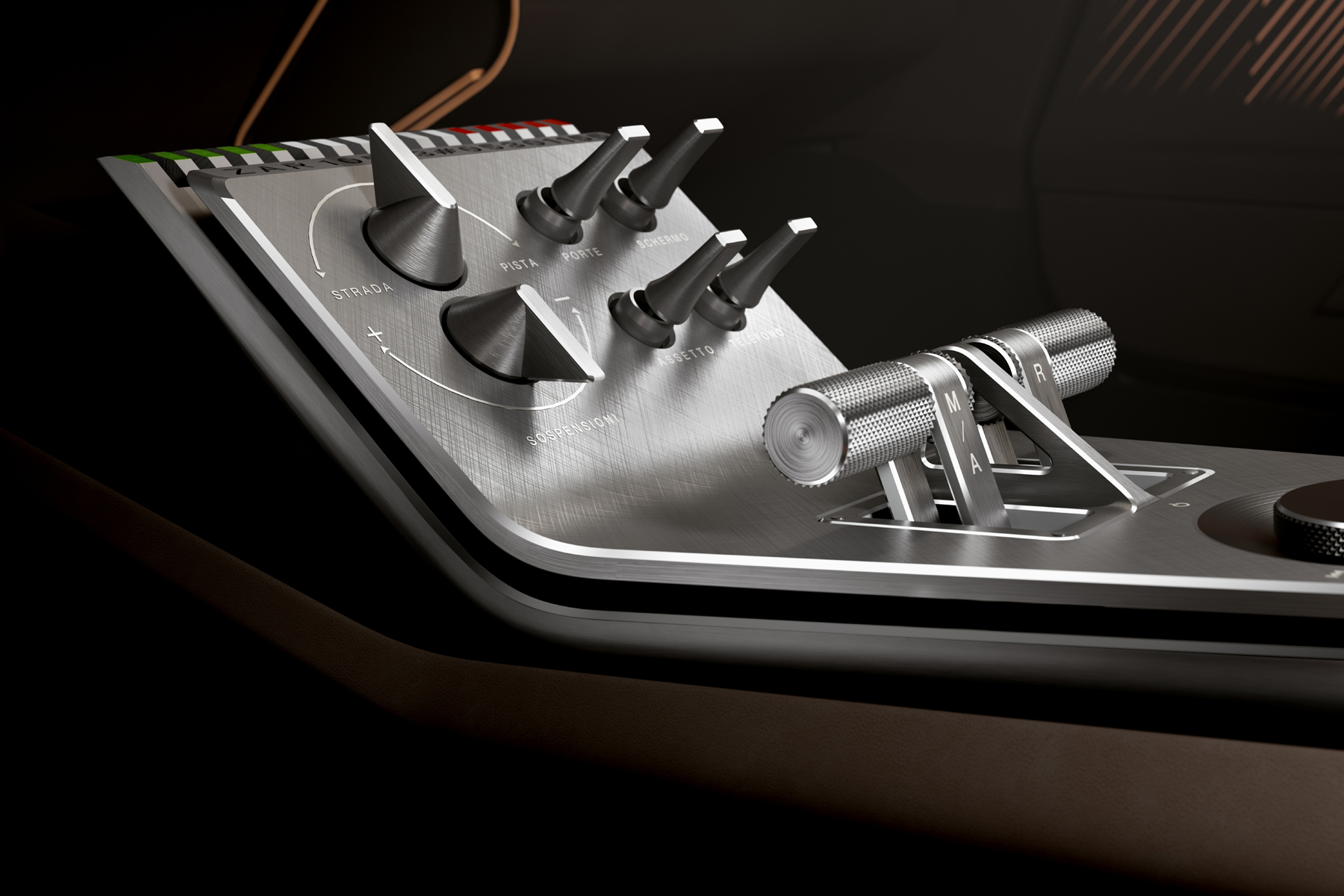
Craftsmanship and customization
Only 33 units will be produced, via a dedicated program that has enabled customers to develop functional stylistic elements together with the Alfa Romeo team: air intakes, wheels and even the distinctive front shield. Therefore, no two cars will be the same. Each is a masterpiece on four wheels, becoming part of Alfa Romeo history. The exclusivity continues in the registration process, which enables customers to personally assign the chassis number. The specific VIN includes eight digits chosen by the customer and also is marked on the central tunnel. For the consolidated experience in the field of exclusive tailor-made automobiles, Alfa Romeo will employ the craftsmanship of the Carrozzeria Touring Superleggera to construct the cars. Tailor-made quality standards are therefore ensured, with obsessive attention to detail.
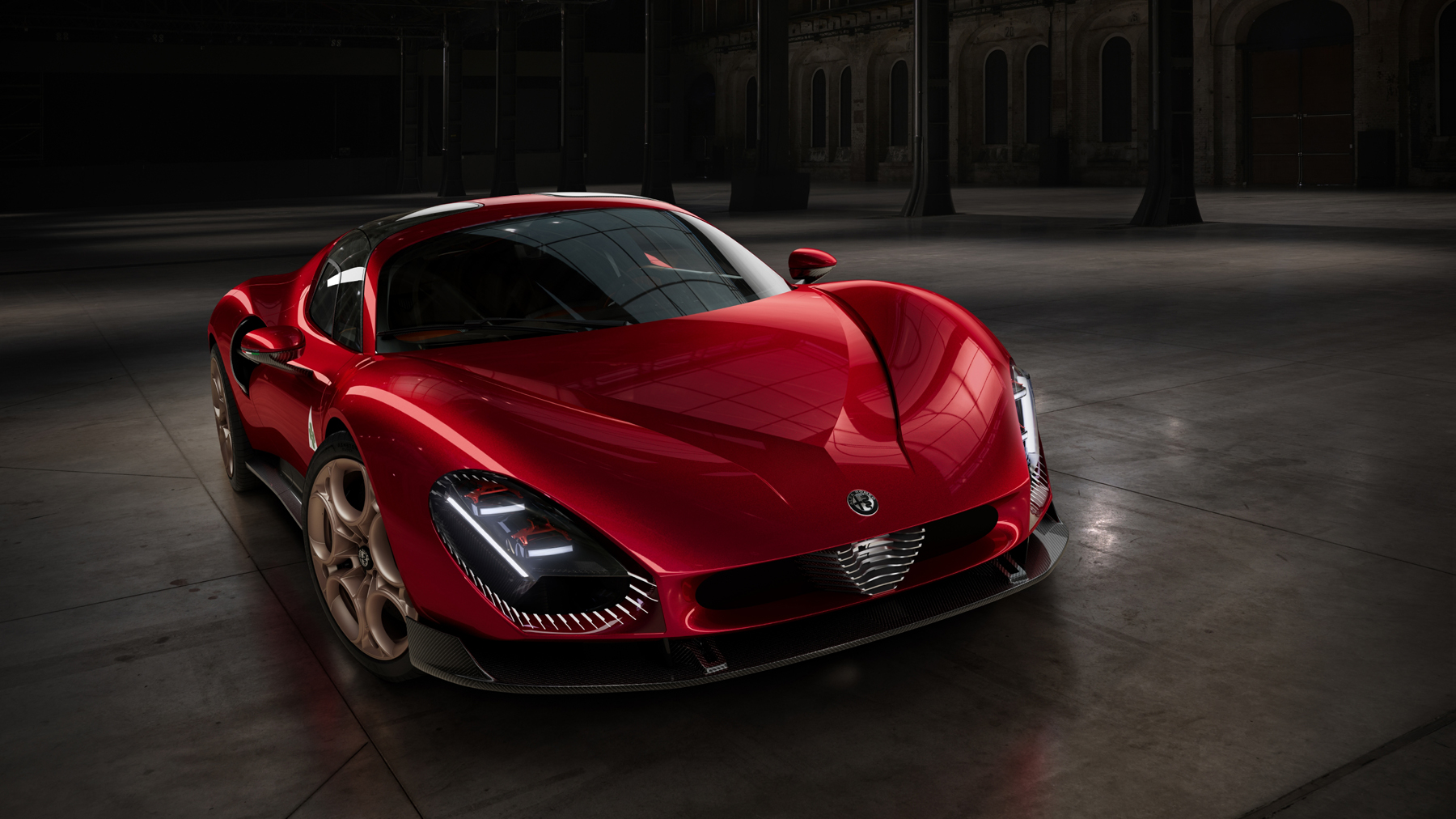
The roots of the legend
The 1967 33 Stradale was derived directly from the Tipo 33, the monarch of world motorsport in that era. Known as Project 33, the program marked Alfa Romeo’s return to racing, led by Giuseppe Eugenio Luraghi, the brand’s then-president, and Carlo Chiti, head of the newly formed Autodelta racing department. The time trial at Fléron, near Liège, was chosen for its debut. The driver was the chief tester at Autodelta, Teodoro Zeccoli. On March 12, 1967, the 33 entered the world of auto racing and scored an immediate victory. That was the first in many successes, including victories at The Championship for Makes in 1975 and 1977. On the wave of enthusiasm, Alfa Romeo produced the 33 in a very limited edition for private individuals as a fuoriserie (custom-built) car that combined the performance of the Tipo 33 racing car with comfort and drivability suitable for everyday use. The design was entrusted to Franco Scaglione, who put his technical expertise and creative daring into the design of the 33 Stradale, resulting in a masterpiece where innovation in style blend with the quest for aerodynamics and functionality.
The design of the 1967 33 Stradale is the quintessence of the beauty of a car. The expressions are the balance of forms, the purity of lines, the elegance of every detail. Between 1967 and 1969, only 18 vehicles were produced, one of which is kept today at the Alfa Romeo Museum in Arese. Six of the original chassis were used to make prototypes, which spread over two decades of automotive design: the Carabo (1968), the P33 Roadster GS (1968), the 33/2 Coupé Speciale (1969), the Cuneo (1971), the Iguana (1969) and the Navajo (1976). In short, the 33 Stradale is a legendary model that has marked not only the history of Alfa Romeo, but also Italian design.
All marterial © 2023 Stellantis / Alfa Romeo


